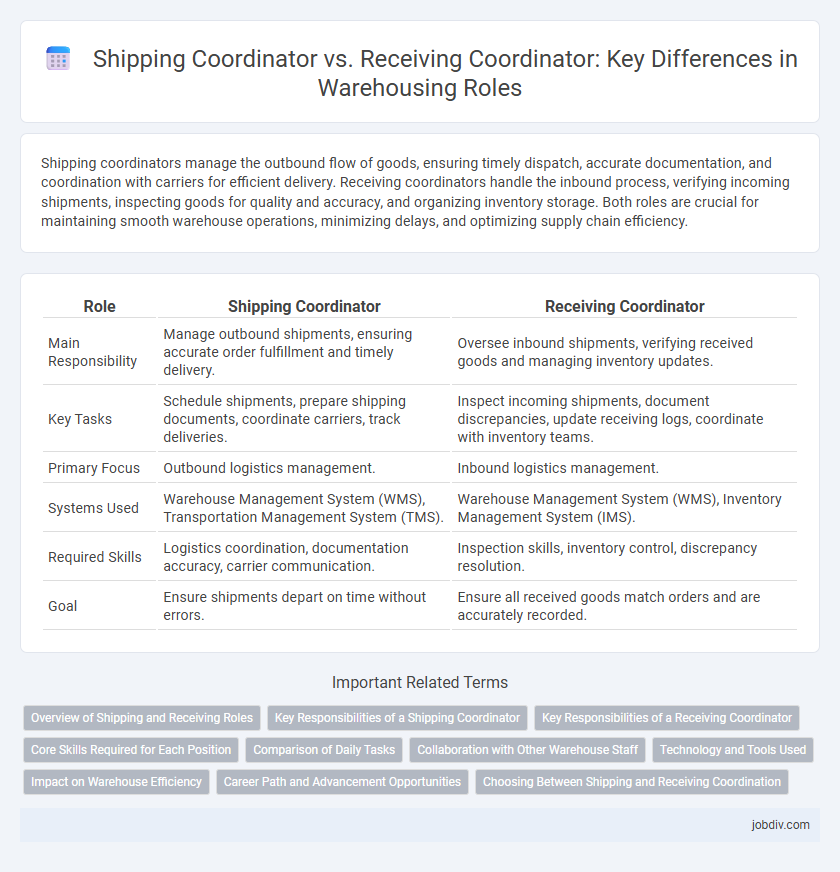Shipping coordinators manage the outbound flow of goods, ensuring timely dispatch, accurate documentation, and coordination with carriers for efficient delivery. Receiving coordinators handle the inbound process, verifying incoming shipments, inspecting goods for quality and accuracy, and organizing inventory storage. Both roles are crucial for maintaining smooth warehouse operations, minimizing delays, and optimizing supply chain efficiency.
Table of Comparison
| Role | Shipping Coordinator | Receiving Coordinator |
|---|---|---|
| Main Responsibility | Manage outbound shipments, ensuring accurate order fulfillment and timely delivery. | Oversee inbound shipments, verifying received goods and managing inventory updates. |
| Key Tasks | Schedule shipments, prepare shipping documents, coordinate carriers, track deliveries. | Inspect incoming shipments, document discrepancies, update receiving logs, coordinate with inventory teams. |
| Primary Focus | Outbound logistics management. | Inbound logistics management. |
| Systems Used | Warehouse Management System (WMS), Transportation Management System (TMS). | Warehouse Management System (WMS), Inventory Management System (IMS). |
| Required Skills | Logistics coordination, documentation accuracy, carrier communication. | Inspection skills, inventory control, discrepancy resolution. |
| Goal | Ensure shipments depart on time without errors. | Ensure all received goods match orders and are accurately recorded. |
Overview of Shipping and Receiving Roles
Shipping Coordinators manage outbound logistics, ensuring timely and accurate dispatch of goods, coordinating carriers, and preparing shipping documentation to optimize delivery efficiency. Receiving Coordinators oversee the inbound process, inspecting shipments for accuracy and damage, verifying inventory against purchase orders, and coordinating storage for smooth warehouse operations. Both roles are critical in maintaining inventory accuracy and streamlining supply chain workflows within warehousing environments.
Key Responsibilities of a Shipping Coordinator
A Shipping Coordinator manages the outbound logistics process by scheduling shipments, coordinating with carriers, and ensuring proper documentation for timely delivery. They monitor inventory levels to avoid shortages and collaborate with warehouse staff to prepare goods for dispatch, maintaining quality control throughout. Precise communication with customers and transport providers is essential to resolve shipping issues and optimize supply chain efficiency.
Key Responsibilities of a Receiving Coordinator
A Receiving Coordinator manages the efficient intake and inspection of incoming shipments, ensuring accuracy in quantity and quality against purchase orders. They coordinate with warehouse staff to organize storage locations and update inventory systems promptly to maintain stock accuracy. Their role involves resolving discrepancies, documenting damaged goods, and facilitating communication between suppliers and internal departments to streamline receiving processes.
Core Skills Required for Each Position
Shipping Coordinators must possess strong organizational skills, attention to detail, and proficiency in logistics software to effectively manage outbound shipments and ensure timely delivery. Receiving Coordinators require keen inspection abilities, inventory management expertise, and strong communication skills to accurately document incoming goods and coordinate with suppliers. Both roles demand problem-solving capabilities and the ability to work under pressure in fast-paced warehouse environments.
Comparison of Daily Tasks
Shipping Coordinators manage outbound logistics by scheduling shipments, preparing shipping documents, and coordinating with carriers to ensure timely delivery, while Receiving Coordinators focus on inspecting incoming goods, verifying shipment accuracy, and managing the receipt process. Shipping tasks emphasize dispatch coordination and compliance with transportation regulations, whereas receiving duties prioritize inventory accuracy and reporting discrepancies. Both roles require strong organizational skills and real-time communication to maintain warehouse flow and optimize supply chain efficiency.
Collaboration with Other Warehouse Staff
Shipping Coordinators collaborate closely with pickers, packers, and forklift operators to ensure timely dispatch and accurate order fulfillment, streamlining outbound logistics. Receiving Coordinators work alongside unloaders, inventory clerks, and quality control teams to verify incoming shipments and maintain precise stock records, optimizing inbound processes. Effective communication and teamwork between both coordinators and warehouse staff enhance overall operational efficiency and reduce errors in order handling.
Technology and Tools Used
Shipping Coordinators utilize advanced Transportation Management Systems (TMS) and barcode scanning technology to optimize route planning and track outbound shipments efficiently. Receiving Coordinators rely heavily on Warehouse Management Systems (WMS) integrated with RFID technology to ensure accurate inventory intake and real-time stock updates. Both roles leverage digital platforms for communication and documentation but apply specialized tools tailored to their respective workflows within the warehousing process.
Impact on Warehouse Efficiency
Shipping Coordinators optimize outbound logistics by managing order dispatch, scheduling transportation, and ensuring accurate documentation, which enhances warehouse throughput and reduces delivery delays. Receiving Coordinators streamline inbound processes by overseeing inspection, inventory updates, and unloading schedules, directly minimizing bottlenecks and improving stock accuracy. Efficient collaboration between Shipping and Receiving Coordinators significantly boosts overall warehouse productivity and reduces operational costs.
Career Path and Advancement Opportunities
Shipping Coordinators manage outbound logistics, optimizing route planning and carrier negotiations to ensure timely delivery, often advancing into logistics management or supply chain analyst roles. Receiving Coordinators focus on inbound operations, overseeing inventory accuracy and vendor compliance, with career progression typically leading to warehouse management or procurement specialist positions. Both roles offer pathways to senior supply chain leadership, emphasizing operational efficiency and strategic coordination within warehousing environments.
Choosing Between Shipping and Receiving Coordination
Choosing between Shipping Coordinator and Receiving Coordinator roles depends on the specific warehouse operations and workflow priorities; Shipping Coordinators manage outbound logistics, ensuring accurate order fulfillment and timely dispatch, while Receiving Coordinators focus on inbound goods verification, quality inspection, and inventory accuracy. Warehousing efficiency relies heavily on seamless coordination between both roles to minimize delays and optimize inventory turnover rates. Decision-makers should evaluate volume of shipments versus inbound deliveries and the complexity of inventory handling to determine the most critical focus area for coordination.
Shipping Coordinator vs Receiving Coordinator Infographic

 jobdiv.com
jobdiv.com